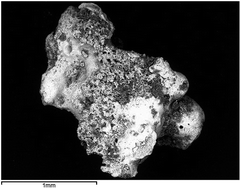Characterising the morphological properties and surface composition of radium contaminated particles: a means of interpreting origin and deposition
Abstract
Radioactive ‘hot particles’ that occur in the environment present specific challenges for health and environmental regulators as often their small size makes them difficult to detect, and they are easily dispersed and accidentally ingested or inhaled by members of the public. This study of nine hot particles recovered from the beach at Dalgety Bay, UK, uses a combination of gamma spectrometry, imaging microscopy and SEM-EDX in order to characterise their morphology and surface composition, thereby helping to identify their origin and source characteristics. The nine particles analysed showed great heterogeneity in their activities, physical form and elemental composition. The particle activities were dominated by 226Ra and its daughters. Three distinct grouping of particles were identified based on their morphology (artefact, glassy and ‘metal-rich’), whilst four distinct groupings (artefact, glassy, angular and porphyric, rounded and highly porous) were identified based on morphology and surface properties as seen in the SEM. Whilst the ‘artefact’ particles were little altered, the other particles showed evidence of incineration. All particles were in a size and/or shape class vulnerable to wind- or water-mediated transport. No correlations were found between morphology and chemical composition. SEM-EDX analysis revealed C, Si, Zn, Fe, Ca are common in the particles together with Ba, Ni, Pb, Cu, Mn and Ti. This is interpreted as the particles being derived from radium containing luminescent paint containing a Zn/S phosphor, a hydrocarbon base and other fillers and additives. Evidence of copper and steel alloys were also present in some particles, whilst one consisted of a hydrocarbon based ‘capsule’. The combination of techniques employed here has enabled interpretation of the origins of the radioactive particles and given insights into the potential movement of particles within the local environment.


 Please wait while we load your content...
Please wait while we load your content...